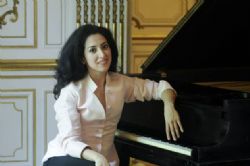|
Chamber
FRISSON DELIVERS SHIVERS OF DELIGHT
by Abby Wasserman
Sunday, March 30, 2025
Chamber
THE PARKER CAPTURES DEMANDING ADES QUARTET AT RAC SEBASTOPOL CONCERT
by Peter Lert
Saturday, February 15, 2025
Chamber
SPLENDID ECHOES ACROSS THE BAY
by Abby Wasserman
Sunday, February 9, 2025
ETHEREAL DUO IN WEILL HALL RECITAL
by Pamela Hicks Gailey
Thursday, February 6, 2025
ESPANA SEGURO AT SO CO PHIL'S JACKSON THEATER CONCERT
by Terry McNeill
Sunday, February 2, 2025
Choral and Vocal
MASTERFUL SINGING CLASS IN SCHROEDER HALL
by Pamela Hicks Gailey
Sunday, February 2, 2025
Recital
MUSICAL POT POURRI AT SPRING LAKE VILLAGE RECITAL
by Terry McNeill
Friday, January 31, 2025
CELLO AND CLARINET HIGHLIGHT TRIO NAVARRO'S CONCERT
by Ron Teplitz
Sunday, January 26, 2025
SONGS OF LOVE, IN A WARM TRIO
by Pamela Hicks Gailey
Sunday, January 26, 2025
Symphony
EARTHLY PLEASURES AT THE VALLEJO SYMPHONY
by Peter Lert
Sunday, January 19, 2025
|
 |
 Pianist Sara Danespour |
MUSCULAR PIANISM DOMINATES MILL VALLEY CHAMBER SOCIETY RECITAL
by Terry McNeill
Sunday, March 12, 2017
Piano recitals since the beginning of the genre open with finger pieces - Scarlatti or Soler Sonatas, Bach, a Mendelssohn Prelude and Fugue or perhaps Mozart or Haydn. Sarah Daneshpour’s March 12 opening work at the Mill Valley Chamber Music Society series abruptly avoided the norm with the 10-minute Boulez “Incises,” written the 1990s. Clearly it wasn’t going to be a conventional recital played routinely or timidly. Recitals don’t begin with Boulez.
“Incises” is a fast percussive piece with fistfuls of notes in both hands, and the artist explored all the piano’s registers with controlled strength. Her pedaling was especially effective in the parts of large washes of sound, alternating with skittish and ferocious sforzandos. The interpretation was unique with strumming effects overlapping phrases and the use of the sostenuto pedal for many measures produced a layered sound. The fermata at the end was long and sealed a potent reading of a ferocious work that was in some ways took artistic courage to program.
Muscular pianism continued with Ravel’s popular Gaspard de La Nuit, but surprisingly the opening Ondine began slowly with inner voices coming to the fore and the modulations underscored. But true to form Ms. Daneshpour deftly ratcheted up the temperature with lyrical sections that were also balanced and never forced. In Le Gibet the slow march was played at just the right tempo to hear the distant bell effects in the bass.
The artist had a command of pianistic sonority that changed from the controlled mezzo piano of the middle movement into virtuoso bravura in the fearsome concluding Scarbo. The rolled bass octaves gave a thunderous impact. Clarity is tough to achieve in this movement that is full of fast repeated notes and powerful climaxes, and at times Ms. Daneshpour’s treatment the diabolical nature of the music was on the edged of too much speed. However, the music can accept such sweep and power, and the audience rose for an ovation following the final eerie right hand notes that were played quietly and without any ritard.
Chopin’s F-Sharp Barcarolle began the second half and the artist took a measured approach with the Italianate melody and arabesque phrase shapes. It was a thorough and rhythmic steady reading that featured minimal rubatos and warm but never splendid tone color. Piano acoustics in the widespread Mount Tamalpais Methodist Church don’t favor rich legato playing and here some of the exquisite undulating theme was not lucid. This was unimportant in the Ravel and the to-come Prokofiev, but in Chopin’s Barcarolle delicate legato is critical.
Returning to the day’s big musical conceptions Ms. Daneshpour closed the recital with a pungent performance of Prokofiev’s Eighth Sonata, Op. 84. In the opening andante dolce the playing was less “dolce” than orchestral, and the artists shaped big contrasts and piquant inner voice notes leading to loud climaxes and an interplay of vocal lines at the end.
The second movement intermezzo was played with soft lyricism that belies the banal theme the composer magically develops. The final Vivace became in Ms. Daneshpour’s hands a lengthy rondo that was played mostly clamorously and with an insistent dissonant bass line. It was a bright and often-raw reading that sporadically had spirited lyricism. Though not as popular as the composer’s “sister” Seventh Sonata in the same B Flat key, the Eighth (finished in 1944) is the greater work, and Ms. Daneshpour’s formidable keyboard artistry and ability to dominate Prokofiev’s percussive and poetic score produced a compelling and convincing musical experience.
There was no encore.
|
